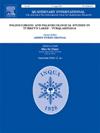Evolution of global vegetation patterns since the last glacial maximum
IF 1.8
3区 地球科学
Q3 GEOGRAPHY, PHYSICAL
引用次数: 0
Abstract
Vegetation evolution is a crucial component of global change research, providing a foundation for understanding the interactions between vegetation dynamics and climate changes. However, current vegetation reconstructions since the Last Glacial Maximum (LGM) have not yet provided a complete and continuous presentation of global-scale vegetation evolution. In this study, we systematically compiled 3286 pollen records and applied the biomization method to reconstruct global vegetation patterns on a millennium resolution since the LGM. Our results show that during the LGM, the mid- and high-latitudes of the Northern Hemisphere were primarily covered by tundra, with steppe and open coniferous forests in western North America, taiga in eastern North America, and steppe dominating much of Eurasia. In the low latitudes, tropical rainforests retreated significantly compared to the present, while arid shrubland expanded across much of Africa. Since the deglaciation, forests have gradually expanded, with cold-adapted biomes shifting to higher latitudes. In the mid-latitudes, mixed forests and deciduous broadleaf forests increased in North America, Europe, and China. During the early to mid-Holocene, forests dominated in the mid- and low-latitudes, while tundra and taiga dominated in the high-latitudes. By the late Holocene, steppe and desert expanded in central North America and northern China, while tropical rainforests flourished in South America. The results further reveal that the global forest cover increased by ∼31 % from the LGM to the mid-Holocene, then decreased by ∼5 % at the late Holocene. In the mid-to high-latitudes of the Northern Hemisphere, forest cover varied significantly, rising notably from the LGM to the early and mid-Holocene, peaking around ∼7–5 ka BP, and declining after ∼5 ka BP. Conversely, the mid-latitudes of the Southern Hemisphere exhibited a more gradual pattern, with forest percentage peaking earlier ∼12–8 ka BP, and maintaining relatively stable afterward. Tropical regions had more erratic changes, initially fluctuating between 18 and 15 ka BP, followed by steady growth peaking ∼4–6 ka BP, and continued fluctuations thereafter. Our results reveal asynchronous vegetation changes across different global regions and provide a biome-level perspective, offering a finer classification of vegetation dynamics compared to previous global-scale studies. This dataset has the potential for comparison with palaeovegetation simulations, promoting better integration with different vegetation classification schemes. Moving forward, increasing the data density and integrating simulations will be crucial for a deeper exploration of the feedback mechanisms between vegetation evolution and climate change, thereby enhancing the accuracy of predictions of future vegetation dynamics.
末次盛冰期以来全球植被格局的演变
植被演化是全球变化研究的重要组成部分,为理解植被动态与气候变化之间的相互作用提供了基础。然而,目前的末次盛冰期以来的植被重建还没有提供一个完整和连续的全球尺度植被演变的呈现。在这项研究中,我们系统地收集了3286份花粉记录,并应用生物化方法重建了LGM以来全球千年分辨率的植被格局。结果表明:在LGM时期,北半球中高纬度地区以冻土带为主,北美西部以草原和针叶林为主,北美东部以针叶林为主,欧亚大陆大部分地区以草原为主。在低纬度地区,与现在相比,热带雨林明显减少,而干旱的灌木丛在非洲大部分地区扩张。自冰川消退以来,森林逐渐扩大,适应寒冷的生物群落向高纬度地区转移。在中纬度地区,北美、欧洲和中国的混交林和落叶阔叶林增加。在全新世早期至中期,中低纬度地区以森林为主,高纬度地区以冻土带和针叶林为主。到全新世晚期,北美洲中部和中国北部的草原和沙漠扩张,而南美洲的热带雨林则蓬勃发展。结果进一步表明,全球森林覆盖在全新世中期增加了~ 31%,在全新世晚期减少了~ 5%。在北半球中高纬度地区,森林覆盖变化显著,从LGM到全新世早期和中期显著上升,在~ 7-5 ka BP左右达到峰值,在~ 5 ka BP之后下降。相反,南半球中纬度地区表现出更渐进的模式,森林百分比在约12-8 ka BP之前达到峰值,之后保持相对稳定。热带地区的变化更加不稳定,最初在18至15 ka BP之间波动,随后稳定增长,达到4-6 ka BP的峰值,此后持续波动。我们的研究结果揭示了全球不同地区的非同步植被变化,并提供了生物群系水平的视角,与之前的全球尺度研究相比,提供了更精细的植被动态分类。该数据集具有与古植被模拟进行比较的潜力,促进与不同植被分类方案的更好整合。下一步,增加数据密度和整合模拟对于深入探索植被演化与气候变化之间的反馈机制,从而提高未来植被动态预测的准确性至关重要。
本文章由计算机程序翻译,如有差异,请以英文原文为准。
求助全文
约1分钟内获得全文
求助全文
来源期刊

Quaternary International
地学-地球科学综合
CiteScore
5.60
自引率
4.50%
发文量
336
审稿时长
3 months
期刊介绍:
Quaternary International is the official journal of the International Union for Quaternary Research. The objectives are to publish a high quality scientific journal under the auspices of the premier Quaternary association that reflects the interdisciplinary nature of INQUA and records recent advances in Quaternary science that appeal to a wide audience.
This series will encompass all the full spectrum of the physical and natural sciences that are commonly employed in solving Quaternary problems. The policy is to publish peer refereed collected research papers from symposia, workshops and meetings sponsored by INQUA. In addition, other organizations may request publication of their collected works pertaining to the Quaternary.
 求助内容:
求助内容: 应助结果提醒方式:
应助结果提醒方式:


